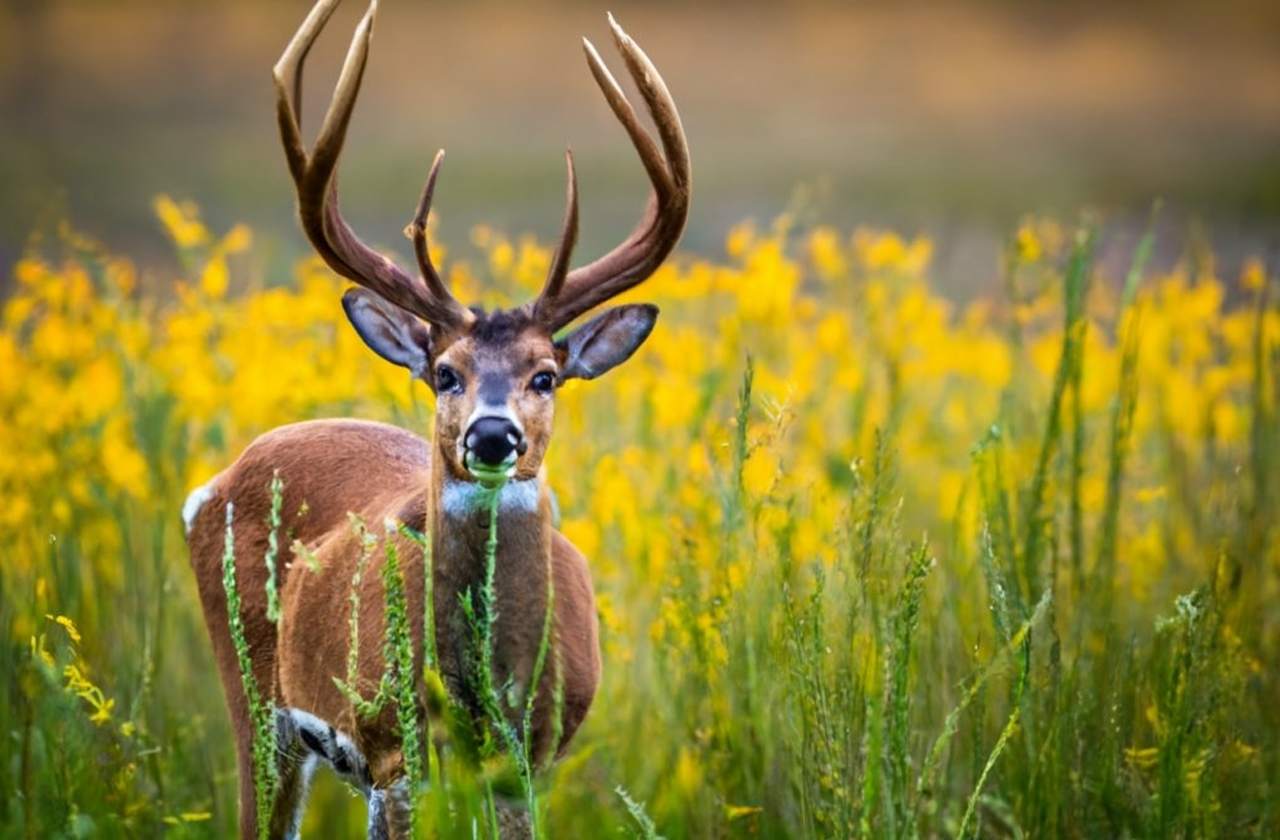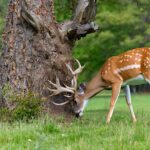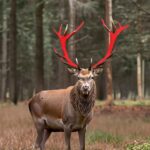The revelation that female deer have antlers adds a fascinating layer to our understanding of their behavior.
Antlers are bony structures that grow from the pedicles, permanent outgrowths of the skull’s frontal bone. Female reindeer, for example, use their antlers to compete with males for food during the winter and to defend their calves. Antler growth is correlated with the season, with antlers developing while the testes are in a regressed state. It takes longer for older males to grow larger, more complex antlers. Failure to grow pedicles or hormonal imbalances can disrupt antler development, leading to deformed antlers. The size and weight of antlers is influenced by factors such as habitat, food availability, and genetics.
Key Takeaways:
- Female deer, with the exception of a few species, do have antlers.
- Antlers are bony structures that grow from the pedicles on the skull’s frontal bone.
- Antlers help female reindeer battle for food and defend their young.
- Antler growth is influenced by factors such as season, age, and hormonal balance.
- Habitat, food availability, and genetics affect the size and weight of antlers.
Does Female Deer Have Antlers?
No, antlers are not present on female deer. A few exceptional instances do exist, such as reindeer (caribou). where it has been seen that female deer develop antlers. Compared to male reindeer, females typically grow antlers that are smaller and less branched. Usually, this is the result of an imbalance in hormones, such when a doe produces too much testosterone. Compared to male deer, female deer usually have smaller, less developed antlers. Generally speaking, female deer lack antlers since they do not need them for the same functions as male deer. Antlerlessness is a secondary sexual trait, and it has developed throughout time.
It is also said in freezing climates, antlers assist scrape through snow to find food, making this adaption essential. Female reindeer use their antlers to guard plowed snow areas with critical food supplies. Larger antlers indicate social dominance and physical strength. Antlers, unlike horns, are shed yearly, although female reindeer keep them until spring during winter pregnancies when food is scarce. Female deer with antlers are unusual outside of reindeer, but this shows how environmental and biological influences shape animals.
| Deer Species | Female Antlers |
|---|---|
| Red Deer | Rare |
| Fallow Deer | No |
| White-Tailed Deer | No |
| Mule Deer | No |
| Roe Deer | Rare |
| Sika Deer | No |
| Chital Deer | No |
| Axis Deer | No |
| Musk Deer | No |
| Chinese Water Deer | No |
| Tufted Deer | No |
| Pere David's Deer | No |
| Milu | No |
| Barasingha | No |
| Sambar Deer | No |
| Eld's Deer | No |
| Thorold's Deer | No |
| Brow-Antlered Deer | No |
| Indochinese Hog Deer | No |
| Visayan Spotted Deer | No |
| Calamian Hog Deer | No |
| North Sulawesi Dwarf Deer | No |
| Philippine Spotted Deer | No |
| Hog Deer | No |
| Reindeer (Caribou) | Yes |
Antler Development and Characteristics in Female Deer
Antler development in female deer is a fascinating process that starts with the formation of pedicles, which are extensions of the frontal bones of the skull. The timing of pedicle development can vary depending on factors such as habitat quality and the individual deer’s genetics. For example, telemetacarpal deer, like roe deer, typically begin developing antlers in the fall of their first year, while plesiometacarpal deer, like red deer, start antler development in their second year.
Initially, the antlers are simple, unbranched spikes, but as the female deer matures, the complexity of the antlers increases. It takes longer for older females to grow larger, more complex antlers. In August/September, the antlers become mineralized, and the velvet covering them dries up and falls off, revealing the hardened bone structure. Female deer may also exhibit other characteristics, such as white spots on their fur and an average weight of around 120 pounds.
To better understand the growth and characteristics of antlers in female deer, let’s take a closer look at a detailed table below:
| Species | First Year Antler Development | Antler Complexity | Mineralization Time |
|---|---|---|---|
| Roe Deer | Fall | Simple, unbranched spikes | August/September |
| Red Deer | Second year | Increasing complexity with age | August/September |
As shown in the table, roe deer begin their antler development in the fall of their first year, while red deer start developing antlers in their second year. Both species experience mineralization of the antlers in August/September, with the complexity of the antlers increasing over time.
The Role of Female Reindeer in Winter and Mythology
Female reindeer, with their impressive antlers, play a crucial role during the winter months. These majestic creatures use their antlers not only to compete with males for food but also to protect their vulnerable calves. By utilizing their antlers, female reindeer are able to navigate the harsh winter conditions and ensure the survival of their offspring.
But the significance of female deer and their antlers goes beyond survival. In mythology, female reindeer hold a special place, often associated with fertility, motherhood, and the rebirth of the sun. They were revered as the “life-giving mother” and depicted in various forms of artwork, such as altars, shrines, and shamanic headdresses.
Symbolically, the antlers of the reindeer were seen as the very tree of life, carrying with them elements of birds, the sun, moon, and stars. This rich symbolism emphasized the vital role of female reindeer in the cycle of life and the interconnectedness of nature. Even today, the image of the female reindeer is celebrated in Christmas cards and decorations, although the profound symbolism and significance might be lost to many.
Key differences between antlers and horns
| Feature | Antlers | Horns |
|---|---|---|
| Gender | Male | Female and male |
| Material | Bone | Keratin (same as hair and nails) |
| Shedding | Shed annually | Not shed |
| Function | Fighting, display | Protection, defense |
Frequently Asked Questions
Do all female deer have antlers?
No, with the exception of a few species, female deer do have antlers.
What are antlers and how do they grow?
Antlers are bony structures that grow from the pedicles, permanent outgrowths of the skull’s frontal bone.
What is the purpose of antlers in female reindeer?
Female reindeer use their antlers to compete with males for food during the winter and to defend their calves.
What factors affect the size and weight of antlers in deer?
Factors such as habitat, food availability, and genetics can influence the size and weight of antlers in deer.
When do female deer start developing antlers?
The timing of antler development varies depending on factors such as habitat quality and genetics. In general, it starts in the fall of their first or second year.
How do antlers develop and change with age?
Antlers start as simple, unbranched spikes and increase in complexity with age. They mineralize in August/September and the velvet covering them dries up and falls off.
What is the role of female reindeer during the winter months?
Female reindeer use their antlers to compete for food and protect their calves, ensuring their survival in harsh winter conditions.
How are female reindeer depicted in mythology?
In mythology, female reindeer are associated with fertility, motherhood, and the rebirth of the sun. They were venerated as the “life-giving mother” and depicted in various forms of artwork.
- California Deer Hunting Guide: Seasons, Rules, Permits, and More - 26 June 2024
- Arkansas Deer Season 2024 [Schedules, Licenses, Bag Limits & More!] - 26 June 2024
- 2024 Arizona Deer Season New Dates & Rules! - 25 June 2024




